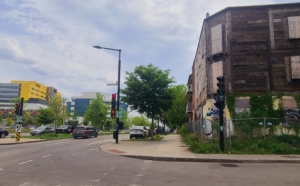Hospitals Don’t Always Cure What Ails A Neighborhood, As One City Learned
Two upcoming residential real estate projects on a street marked by boarded-up windows across from the $1.3 billion McGill University Health Complex may fulfill some of the long-awaited promise of local economic rejuvenation after the hospital’s 2015 completion.
They also beg a larger question about North American hospitals: why are some nearby areas unattractive to property investors?
While city officials expected the 2.4 million-square-foot health complex and its 11,500 employees to attract ancillary development to the surrounding streets, the hospital went almost a decade without delivering the desired investment.

Montreal’s MUHC major medical center, seen on left, may begin to spark investment in the surrounding area after almost a decade. (PHOTO CREDIT: Kristian Gravenor/CoStar News)
That came as a surprise locally because the super hospital, as locals call the massive MUHC facility, united five hospitals from elsewhere in town into a series of new buildings totaling 2.4 million square feet built on a former rail yard. The project was the biggest local real estate undertaking since the Montreal Olympics of 1976 and resulted in over 11,000 employees working at the facilities and almost 1 million patients and visitors annually.
Retail space in the structure includes about 20 outlets covering 25,000 square feet, with about one-third of that space occupied by food services and the rest used as gift stores, banks and pharmacies. Even so, little residential development has been built in the area since the arrival of the hospital, even though living near a hospital might appear to confer the advantage of allowing rapid arrivals for emergency healthcare.
However, even that apparent upside might be illusory, according to Hal Newman, a former paramedic who posts regular updates on emergency healthcare in the Montreal region as part of his Last Ambulance research project.
“Sadly, living in close proximity to a hospital doesn’t improve your access to care, especially in the case of an emergency,” Newman said in an email. “Delays after arriving at a hospital remain a large determinant of health outcomes. Geographic proximity is not going to improve your access to care in an ER where triage is the key determinant of how long you will need to wait before being seen.”
City planners and academics place hospitals and universities in a category called the anchor economy, as both institutions bring long-term investment to an area and rarely move away. While data shows universities help raise nearby real estate values, hospitals tend to have the opposite effect of lowering home price values, at least according to one study in the Journal of Big Data from 2017.
That study concluded that hospital staff prefer not to live near where they work but rather they often seek to live in wealthier areas farther away: “…hospitals’ professional staff, some highly paid doctors…are adults mostly with families that compete for larger homes in neighborhoods having amenities commensurate to their needs and desires.”
According to recent data from the Anchor Economy Initiative compiled by the Federal Reserve Bank of Philadelphia, hospitals and universities provide a valuable economic resource to an area because they, “employ local residents, invest in community development projects, keep regions healthy and provide education, which all fuel and sustain local economies.”
Eds And Meds
The economic impact of this category, or eds and meds, as some academics describe the combination of schools and hospitals, varies by region, with Ithaca, New York, ranked as the U.S. area with the highest economic dependence on the anchor economy and Midland, Texas, ranked the least dependent. The ranking is based on recent data created by compiling numbers from the Bureau of Labor Statistics, the Bureau of Economic Analysis, and the Department of Education to analyze 393 metropolitan areas and 131 non-metropolitan areas in the United States.
Hospitals wield a larger effect on a local economy than universities, according to the research. Yet despite their economic clout, hospitals tend to raise rents and home prices in the surrounding area less than universities in the United States. Indeed, areas around hospitals have lower residential real estate values than the local average in the United States, according to a team of academics who combed through reams of real estate data in 2019 only to conclude that “ZIP codes with hospitals tend to have below average median home price and median rent.”
The researchers, a group of computer scientists from the University of California, Riverside, concluded that the causes are “complex” and “hard to measure.”
The studies only analyzed data from the U.S. but the conclusions appear to be supported in Canada’s second-largest city in the area surrounding the CA$1.3 billion McGill University Health Complex, built between 1997 and 2015 just west of downtown Montreal.
Authorities expected the hospital to have a significant effect on the surrounding area, as the Montreal Public Consultation Office predicted in 2005 that the project would lead to the addition of 400,000 square feet of healthcare-related real estate facilities and 43,000 square feet of new retail to the area around the hospital.
But the immediate boom never happened. Few health clinics have sprouted up nearby, offices in the area sit empty and the retail situation has not improved. Any hopes that off-duty staffers might frequent local bars and restaurants have also fizzled, as few new establishments have opened and long-standing local area favorites such as Momesso’s, Claremont, Copoli and Maz now sit vacant and empty.
“The MUHC super hospital failed to make a larger effect on the area because employees tend to arrive and leave through the adjacent metro station without visiting the area,” David Farrell, a longtime MUHC staffer told CoStar News in an interview. “Guests and patients seek to avoid high parking costs within the hospital facility by parking on nearby streets, leading to parking headaches that make the area less appealing for would-be residents. Restaurants and retail have not thrived because they require a significant walk from the hospital and the complex is not well designed to accommodate food delivery for take-out orders.”
The issue of businesses relocating to the area remains a “matter for the private sector” and municipal authorities “have little leverage to encourage companies to locate in the area,” a city of Montreal representative told CoStar News in an email. A total of 14 medicine-related businesses, such as pharmacies and clinics, have opened in the area around the hospital since 2011, according to the city’s occupation certificate records, including six at 5100 de Maisonneuve W, three at 5325 Crowley and two at 5252 de Maisonneuve W.
Another problem contributing to the lack of new development and business expansion in the area around the hospital has been hopeful property owners charging higher rents in the area than they did before the arrival of the healthcare facilities, leading to some extended vacancies between tenants in the vicinity of the hospital, according to a variety of local real estate professionals.
Signs Of Revival
There are signs that the area near the Montreal medical center is slowly picking up. Last year Groupe Maurice opened a 336-unit retirement home near the hospital after many years of delay and public zoning debates.
Another pair of residential projects have inched forward to replace a forlorn series of properties across the street from the hospital. The new projects have been planned on a strip where drab abandoned buildings offer a stark contrast to the colorful hospital structures.
One of the two projects is set to bring 289 apartments over seven floors at the corner of Crowley and Decarie, directly across the street from the hospital. Developer Rachel Julien, best known for an ongoing residential project near the Olympic Stadium, purchased the property in 2020 and got the green light from municipal authorities to build a seven-floor tower complete with a courtyard, coworking space, rooftop terrace, bike repair space and 62 parking spaces in two underground floors, company Vice President Mélanie Robitaille said in an interview. The company aims to start construction later this year and complete the project within 24 months.
A second project by PUR Immobilia, led by real estate development veterans Philippe Bernard and Yan Lapointe, aims to replace derelict, boarded-up buildings on Decarie between Crowley and a Mazda dealership about 600 feet to the south, with a series of apartment buildings ranging from eight to 12 floors. Bernard said his company has been planning the project for about four years but only acquired the land last fall and hopes to launch construction by the end of this year.
“Americans appear to have a greater awareness of the importance of the anchor economy,” University of Toronto professor Richard Florida, an American urban studies theorist who has taught in Canada since 2007, told CoStar News in an email. “I think this has all been slower to catch on in Canada than the United States, where it has evolved over the past several decades.”
Florida notes the anchor concept benefits an area by generating economic opportunities within the circle of nearby businesses.
“Anchor institutions have worked to provide jobs for their communities and have worked to buy things from their communities, so-called local sourcing. They provide job training and more,” Florida said.
Source: CoStar
For more information contact us:
954.346.8200 x 201




